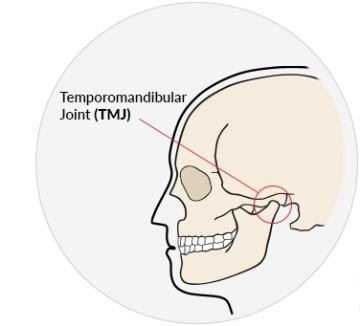TMD pain management - GNM orthotic

The temporomandibular joint is a hinge that connects your jaw to the temporal bones of your skull, which are in front of each ear.
It lets you move your jaw up and down and side to side, so you can do things such as talk, chew and yawn.
Problems with your jaw and the muscles in your face that control it are known as temporomandibular disorders (TMD).
Some of the symptoms could arise from problems with the muscles of your jaw or with the parts of the joint itself. Injury to your jaw, the joint, or dysfunction of the Orofacial muscles [also known as OMD], muscles of the head and neck can lead to TMD issues.
Other causes include:
- Grinding or clenching your teeth, which puts a lot of pressure on the joint
- Movement of the soft cushion or disc between the ball and socket of the joint


Common symptoms include:
- Pain or tenderness in your face, jaw joint area, neck and shoulders, and in or around the ear when you chew, speak, or open your mouth wide
- Problems when you try to open your mouth wide
- Jaws that get “stuck” or “locked” in the open or closed-mouth position
- Clicking, popping, or grating sounds in the jaw joint when you open, close your mouth or chew. The result of these sounds may or may not be painful
- A tired feeling in your face
- Trouble chewing or a sudden uncomfortable bite- as if the upper and lower teeth do not fit together properly
- Swelling on the side of the face
- You may also have toothaches, headaches, neck aches, dizziness, earaches, hearing problems, upper shoulder pain, and ringing in the ears (tinnitus).
TENS is short for ‘transcutaneous electrical nerve stimulation’. In other words, electrodes are attached to your skin that stimulates your nerves. There are many kinds of TENS that can cause many different effects.
- Here @ DP DENTAL, we use low-frequency TENS that causes your muscles to contract and relax in a precise sequence and at a scientifically determined rate so they are able to work out tension and eliminate toxins—it’s like an electric-stimulated self-massage.
- In addition to relaxing your muscles, the TENS massage stimulates the release of endorphins, hormones that can block pain and improve your mood.
- Once the TENS massage has relaxed your muscles our trained dentist, can examine your teeth and jaw to determine whether additional treatment may be necessary. Using sophisticated equipment that produces objective measurements they determine the position of maximum rest for your muscles, and whether your jaw can rest comfortably in that position.
After TENS therapy, most people need additional treatment, such as bite splints (also called orthotics, etc.) that are worn most of the time, dental restorations to build your bite back to healthy proportions etc.
